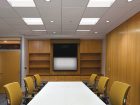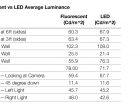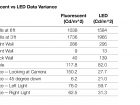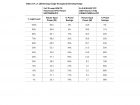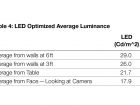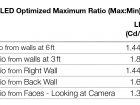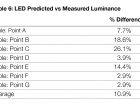
Features
Articles
Can you see me now? An analysis of the use of LED lighting for videoconferencing
December 12, 2016 | By J. Yorgey F. Neher J. Volkert and C. Katrinak

December 12, 2016 – Lighting a videoconferencing (VTC) environment presents a unique challenge as it must provide equal, excellent visual access to participants in the room as well as those in remote locations. The lighting must accommodate the visual requirements of the people and the camera, and provide visibility of any display materials, especially to remote participants.
Achieving the proper lighting balance requires the right combination of fixtures and control strategies.
Linear fluorescent sources have long been used to provide effective, uniform lighting in VTC environments. As LED solutions offer the opportunity to save energy and reduce costs, lighting designers are looking for assurance these solutions can also deliver similar or better results, and to understand the additional benefits associated with using LEDs.
Dimming controls are essential to creating that ideal solution in VTC environments regardless of the source, and appropriate control solutions are the other key to success.
New research provides tangible data that will allow designers and facility managers to be more comfortable with the use of LED fixtures and controls in VTC environments, and to confidently include LED solutions into room specs and applications.
A look at the types of fixtures required
During a videoconference, the camera doesn’t see the way the human eye does. Improper lighting can cause the camera to produce saturated images or images with dark shadows on them, resulting in poor picture quality for remote participants.
The right combination of strategically placed fixtures improves vertical illumination, creates uniform lighting on surfaces and participants and, with the addition of controls, enhances the ability to adjust contrast in the space. Critical contrasts include:
• participant-to-rear-walls
• participant-to-side-walls
• participant-to-work-surface
• display-wall-to-video-display
Other factors, including room colour and colour/texture of furnishings, can also contribute to, or detract from, effective VTC room design.
To further ensure image clarity, it is important to implement a solution that offers fluorescent fixtures with dimming ballasts and/or LED fixtures with dimmable drivers in various form-factors to fit a variety of different space types and applications.
In either case, a combination of 1×2 and 2×2 indirect fixtures provides both vertical and horizontal illumination, and helps produce images with better contrast and sharpness. The right combination of fixtures ensures high-quality lighting on the participants, walls and table surfaces, as well as the area around the display, screen or monitor.
VTC solutions for several space types
Ideally, a corporate space will have a dedicated videoconferencing room, but space is often at a premium, and the guidelines we are defining are advantageous in a number of spaces that may be used for meetings, conferences and educational activity, such as:
• VTC rooms
• Telepresence rooms
• Distance learning spaces
• Training rooms
• Boardrooms and conference rooms incorporating video capabilities
A look at fluorescent versus LED fixture solutions
Over the course of many years, fluorescent fixtures have proved to provide even, controllable lighting in VTC spaces, and lighting designers may be hesitant to veer away from fluorescent solutions without a clear understanding that LEDs offer equivalent lighting with additional advantages.
LED fixtures and controls are becoming less expensive and more widely available, and now offer a viable alternative design solution, delivering benefits that make LED fixtures highly desirable in virtually any VTC application. They are energy efficient, offer long life and lower heat dissipation and, by working with the right provider, offer guaranteed compatibility between the fixture and the controls.
LEDs use less energy initially and save energy at a roughly 1:1 ratio as they are dimmed. They provide uniform light levels/consistent colour temperature, with little degradation or colour shift over their life span, which can reach 50,000+ hours (even longer when dimmed).
Because they dissipate very little heat, LEDs further increasing energy savings by reducing demand on HVAC cooling systems. As for compatibility, the LED light source is included in the fixture, ensuring compatibility between module and driver. By choosing a manufacturer who specifically provides fixtures and controls together, you can guarantee compatibility and smooth, flicker-free dimming. Finally, lighting performance is not compromised, as LED fixtures provide the same glare-free lighting as their fluorescent counterparts.
Compatibility between the driver and fixture is key to LED lighting performance. The selection of an appropriate driver is not limited to just making sure it matches the LED module being used; the driver is the primary component that determines the best-possible dimming capabilities of the LED lamp or fixture.
It is also important to understand by what mechanism the LED driver achieves dimming: pulse-width modulation (PWM) or constant-current reduction (CCR). Drivers using CCR are critical for videoconferencing applications to ensure good performance on-camera.
Optimized solutions
The Illuminating Engineering Society’s (IES) design guide DG-17-05 “Fundamentals of lighting for videoconferencing” goes into great detail explaining the importance of environment when creating a space ideal for VTC functions. Among the details, it describes what efforts should be taken to ensure appropriate lighting.
The guide calls out ideal specs for light sources, including a correlated colour temperature (CCT) in the 3000K to 3500K range, and an 80 CRI (colour rendering index) or higher. It also emphasizes the importance of meeting the minimum light level requirements of the camera, and providing even contrasts in lighting throughout different parts of the room to prevent saturation and washouts.
DG-17 strongly suggests the use of controls to achieve this balance of light levels, to provide both the minimum quantity of light without being overlit and good contrast ratios. A dimming system facilitates the ability to adjust the light levels within the space to ensure the proper balance of light.
Modelling versus performance
When designing a space with such specific requirements, it is vital the solution can be modelled and the results accurately predicted. Predictive models allow the designer to see the solution in terms of fixture layout and light output without investing the time and money in a physical mock-up. A trusted model delivers confidence the proposed solution will meet the space requirements prior to purchasing a piece of equipment.
Predictive modelling can be done using IES files and modelling software. By modelling the space, designing and tweaking the fixture layout—and including the IES file photometric data for the specific fixtures—the actual photometric layout of the room can be created and analyzed. This model enables the user to observe and/or analyze the light levels throughout the space, as well as the contrasts between dark and bright spots. This allows for further consideration regarding fixture type and placement, as well as the application of control systems.
Case in point: a before/after analysis
What follow are the results of a case study comparing the use of fluorescent versus LED fixtures and controls in a recently designed VTC room. The data will demonstrate that LED solutions can provide the same, flicker-free 1% dimming previously only available with a fluorescent solution and with lower energy use.
Table 1 shows average luminance data for the two solutions at 100%. The light output of the LED solution is capable of producing the same quantity of light as the fluorescent solution. Looking at the variance data in Table 2, we can see the variation in light output across the different surfaces is also very similar.
The variance in the data set is a measurement in the spread of values away from the mean of the set. In this analysis, the measurements can be used to represent overall difference in light measurements along a surface. It cannot be determined from this data set what an acceptable variance is for each surface, but rather to compare the overall light environment provided by the two solutions.
When considered surface-by-surface, the data set variances between the fluorescent and LED solutions tend to mirror each other along a surface. This illustrates that the fluorescent and LED solutions provide equivalent light outputs, and the variance in light level is most likely due to the fixture layout rather than differences in the light sources themselves.
As discussed previously, LED solutions have intrinsic benefits, the primary one being energy savings. The direct comparison of equivalent 2×2 LED and fluorescent fixtures shows that, at 100% output, the LED fixture uses about half the power of the fluorescent. They also save energy linearly, resulting in further energy savings as the LED fixture is dimmed, especially as they are dimmed toward their low end. This is important to consider since these fixtures should be paired with a dimming system and dimmed down to optimize light output.
In this study, the optimized solution was implemented with all light source types present in the room, including the wallwash fixtures, indirect wash fixtures and recessed downlights. Having already tested, analyzed and determined the LED VTC fixtures could output light equivalent to a fluorescent, it was prudent to analyze an optimized solution as it would appear in normal use than to prepare an optimized solution with just the indirect wash fixtures.
The values for this optimization were found to be wallwash at 30%, indirect wash at 20%, and recessed downlights at 10%. The IES guide suggests a maximum luminance ratio of 1.5:1 from the maximum to minimum of the walls behind the participants, or from the faces of participants, to provide quality video feed from the space. The results in Table 5 show the optimized LED solution max-to-min ratios were all around 1.5:1. Table 4 shows the average light level on the table while achieving these proportions was at an acceptable level.
Finally, the predicted versus measured data in Table 6 proves the results of using a videoconferencing fixture layout with control system can be accurately predicted. In this data set, there is an average variation of 10.9% between what was predicted and what was experienced onsite. The difference can be attributed to the slight variation in fixtures, variations in the surfaces within the room, as well as slight changes in the control system adjusting the light levels up and down.
This data confirms the results can be predictably modelled within a reasonable margin of error, making it easier to design VTC room lighting and control prior to obtain the desired results before investing in equipment or time onsite.
Model and control
As LED sources become more available and cost effective, lighting designers can be confident they will deliver the performance and flexibility their clients have come to expect from fluorescents. Knowing that LEDs can offer equivalent light levels empowers the client to focus on the intrinsic benefits of an LED solution; namely, energy savings and longer life. Understanding those benefits, it becomes critical to be able to reliably design a solution with confidence and without requiring substantial investment.
The fact that these solutions can be accurately modelled, and the results reliably predicted, is great news for good design and experimentation without requiring investment of time and resources.
Seeing the equivalence between LED sources, understanding the intrinsic benefits, and being able to accurately model and predict performance removes any obstacles for LED solutions, thereby opening the door for them to be used as the new standard for videoconferencing spaces.
This article is adapted from the technical report “An analysis on the use of LED lighting for videoconferencing” by Jim Yorgey, P.Eng., Frank Neher, Joe Volkert and Christina Katrinak, Lutron Electronics, March 2016. You can access the full technical report at tinyurl.com/jo4pjvh (PDF, 215kB).
Print this page
